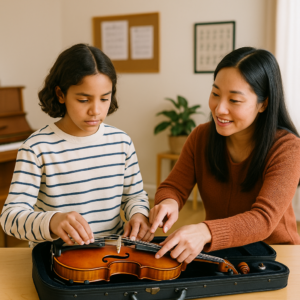As a group of private music teachers specializing in beginner students, we often emphasize why understanding the anatomy of the violin matters. Knowing the parts of the violin helps new players care for their instrument, follow instructions accurately, and build confidence from day one.
Key Parts of the Violin
Here’s a numbered breakdown of essential violin components:
-
Scroll & Pegbox – Decorative top and housing for tuning pegs.
-
Pegs – Turn to tune strings by adjusting tension.
-
Fingerboard – Smooth surface where fingers press notes.
-
Neck & Nut – Supports the fingerboard and spaces strings correctly.
-
Body (Top, Ribs, Back) – Resonates sound; spruce top and maple back/ribs.
-
Bridge – Transfers string vibrations to the body.
-
Sound Post & Bass Bar – Internal supports impacting tone quality.
-
Tailpiece & Chin Rest – Anchors strings and gives a place for the chin.
Understanding these parts helps beginners follow instructions like “place your finger behind the nut” or “place the bridge upright.”
Why Knowing the Parts Helps Beginners
New students benefit from having the anatomy of the violin explained clearly for several reasons:
-
Easier Setup & Tuning: Students can identify pegs, bridge, and fine tuners independently.
-
Instrument Maintenance: Spotting wear on the bridge or cracks in the ribs helps prevent bigger problems.
-
Vocabulary for Communication: When teachers say “adjust bow above the fingerboard,” students instantly understand.
Caring for Your Violin
To protect the violin’s structure and sound:
-
Wipe the strings and body after playing to remove rosin buildup.
-
Loosen the bow hair slightly when not in use to prevent warping.
-
Store in a stable case to keep humidity and temperature consistent.
Additional Resources
-
Learn how tuning and maintenance fit into your practice routine by signing up for lessons.
-
This article from Strings Magazine provides expert insight into violin anatomy and its effect on tone.
FAQ
Q: Why is the sound post important?
A: The sound post supports the violin’s structure and optimizes resonance between the top and back plates.
Q: How often should I check the bridge alignment?
A: Beginners should check the bridge every few weeks or after tuning. A tilted bridge can affect playability and sound quality.
Q: Can a beginner understand violin anatomy fully?
A: Yes. When the anatomy of the violin is explained clearly—part by part—beginners easily grasp setup, tuning, and maintenance.
